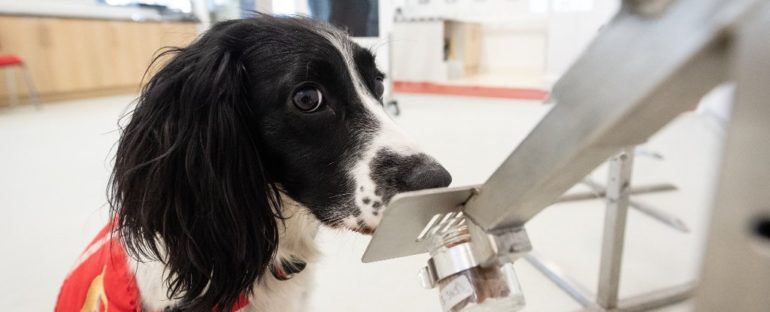With the right training and motivation, the smartest dogs can detect up to 40 different types of bombs, sniff out tiny traces of drugs, perform extensive search-and-rescues, and smell the colon cancer in our farts. They might even catch a whiff of SARS-CoV-2 in our sweat.
A proof-of-concept study in France and Lebanon has successfully trained six working ‘detection dogs’ to pick up the smell of patients who have been sickened by the novel coronavirus.
In less than a day, many of these professional canines had already memorised the scent. Within weeks, the dogs had been trained to correctly mark which sweat samples came from symptomatic COVID-19 patients, and which didn’t.
In the final test, some dogs had a success rate of 76 percent. Others were correct 100 percent of the time. The research is limited and the results preliminary, but accumulating evidence suggests trained dogs may be a rapid, reliable and cheap way to screen (not test) for COVID-19.
“These results provide some evidence that detection dogs may be able to discriminate between sweat samples from symptomatic COVID-19 individuals and those from asymptomatic COVID-19 negative individuals,” the authors of the study write.
Further research is still needed, including a double-blind version of the tests, but researchers in France think there’s every reason to keep going.
If future studies can show a dog’s sense of smell is sensitive and specific enough to COVID-19 infections, national authorities could consider using trained detection dogs to pre-screen for the virus, or perform rapid checking among large groups of people.
Already, many nations around the world are training dogs to do just that, including Chile, Argentina, Brazil, Australia, and Belgium. A pilot scheme in Finland has even shown dogs at Helsinki Airport could detect COVID-19 almost 100 percent of the time.
It’s still not clear what exactly dogs are smelling in these situations, but the researchers hypothesise that once SARS-CoV-2 is within human cells, it can break down certain molecules in our sweat, breath, urine, tears, saliva and faeces, generating particular volatile organic compounds (VOCs).
Wafting off our skin, these VOCs contribute to a person’s body odour, which is potentially what dogs are smelling when they sniff for COVID-19. In fact, this same principle is what allows them to detect certain types of cancer.
If that sounds downright impossible, consider this: Humans have roughly 6 million olfactory receptors, while dogs have up to 300 million. In practical terms, that means canines can sniff out a scent even when its concentration is one part per trillion.
The study on COVID-19 detection was conducted at two sites, one in Paris and another in Beirut. In total, six working detection dogs were recruited, and 177 individuals from five hospitals (one in Beirut) consented to have their underarms swabbed for sweat.
Roughly half of these patients tested positive for COVID-19 and were showing symptoms, while the other half were asymptomatic and COVID-19 negative.
For one to three weeks, detection dogs were trained by their handlers to mark a sample that smelled COVID-19 positive. Once they were able to do this, the dogs were then tested, with both the pet and its handler blind to the location of the positive sample.
In each session, swabs of sweat were randomly placed behind three or four olfactory cones, all presented at once. The dog sniffed these before marking the one it thought was positive for COVID-19.
The results are truly impressive, but there are some limitations. While both the handler and the dog were initially blind to the location of the positive sample, once the dog marked the right sample, the handler was told so they could issue a reward. This means it’s only a single-blind study.
Plus, sometimes the same positive COVID-19 swab was used three times for one dog, which means the canines might be memorising the right answers.
That said, researchers did not find any changes in the success rate when a dog was presented a sample for the first, second, or third time. In fact, half the dogs trained in Paris had higher success rates the first time the swab was introduced.
“These results support the hypothesis that olfactory memory did not play a major role, if any, in the discrimination task in our study,” the authors write.
One of the other main limitations is that the dog was given all the scents in a simultaneous line-up as opposed to a sequential one, which means we can’t really determine how sensitive or specific a dog’s nose actually is between samples.
The authors fully acknowledge these imperfections, but they also made several important updates to research being carried out elsewhere in the world.
Different samples, for instance, were used when training and testing the dogs, and the number of detection canines and hospital patients was quite large compared to other initial studies.
Even if they prove useful in the current pandemic, detection dogs aren’t about to start replacing COVID-19 tests. But by helping humans to screen large numbers of people quickly, they could be a really important way to help stall further outbreaks and contain the virus, especially in regions of the world with little access to tests or the money to buy them.
Thank goodness for dogs.
The study was published in PLOS One.



